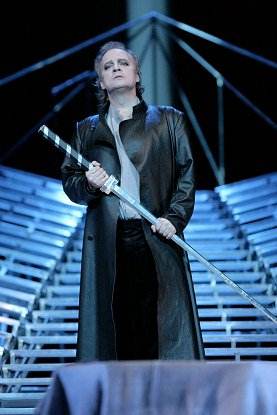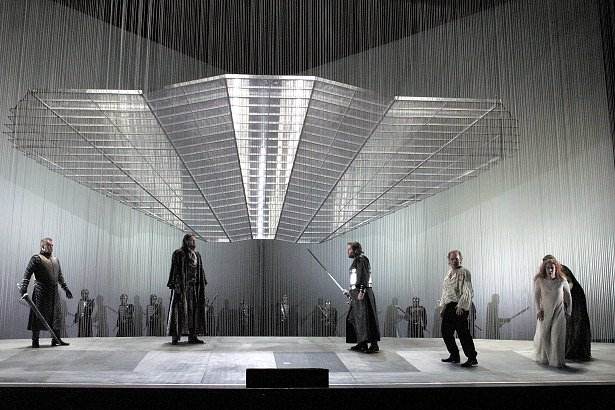S & H International Opera Review
RichardWagner, ‘Tristan und Isolde’, Royal Swedish Opera, Stockholm, 13th March 2004 (new production premiere)(BK)
Mortgage your Grandmother for a flight to Stockholm if only to hear Nina Stemme: last season’s Glyndebourne Isolde has returned to Sweden in a new Hans-Peter Lehmann production that demonstrates her talents to the full. The voice is lyrical and effortlessly powerful, completely free from strain throughout its entire compass and her acting is both subtle and persuasive. She is ein richtiges Phänomen without doubt.
Lehmann’s production is straightforward, uncomplicated and intelligent, reflecting his firm belief that Wagner’s text itself provides the best grounding for any new interpretation, although his preparation also involved reading Nietzsche, Thomas Mann and Novalis apparently. The setting is in mythological time and has an appropriately minimalist stage design by Olaf Zombeck, faintly reminiscent of Wieland Wagner’s sets from the 1960s.
In all three acts a gently sloping stage is bounded by two flats to form a deep triangle. The prow of the ship in Act I is represented by a slatted metal structure which becomes both a starry sky and the exterior of King Marke’s castle in Act II. A similar structure forms part of Kareol’s walls in the third act. Few other properties are used or needed since all other suggestions of atmosphere and location are provided by Linus Fellbom’s elegant, and often beautiful, lighting plot.
Dramatic representation is equally unfussy in this production, so that things are exactly as they seem to be. Tristan and Isolde are unambiguously attracted to one another while painfully aware of their tragic circumstances, even before the love philtre. King Marke is obviously saddened and angry at Tristan’s apparent betrayal and Brangäne and Kurwenal are unequivocally loyal servants. Nothing is ever overstated here but meaning is always clear: staged ecstacy can, and perhaps should, be expressed without excess. Text and music are sufficient in themselves.
Nina Stemme aside, this is musically a strong production since Leif Segerstam is a seasoned Wagnerian. All the principals were in excellent voice for this première performance, with particularly fine singing from Lennart Forsén as Marke and from Gunnar Lundberg as Kurwenal. Wolfgang Milgramm’s Tristan was rather muted in Acts I and II and it was fairly obvious that he was holding back deliberately to keep full voice for the rigours of Act III. He did not disappoint however; his vocal portrayal of Tristan’s delirium and death were splendidly dramatic and powerful. The audience was wildly appreciative of the whole thing and showed their enthusiasm with a prolonged and noisy standing ovation. And quite right too.
Bill Kenny
CAST
Tristan: WOLFGANG MILLGRAMM
King Marke: LENNART FORSÉN
Isolde: NINA STEMME
Kurwenal: GUNNAR LUNDBERG
Melot: MAGNUS KYHLE
Brangäne: MARTINA DYKE
A Shepherd: ULRIK QVALE
A Helmsman: JOHN ERIK ELEBY
A Young Sailor: ULRIK QVALE
Men of the Royal Swedish Opera Chorus
Royal Swedish Opera Orchestra
Conductor: LEIF SEGERSTAMProducer / Director: HANS-PETER LEHMANN
Set and Costume Design: OLAF ZOMBECK
Lighting: LINUS FELLBOM
Pictures by ALEXANDER KENNEY, courtesy of Royal Swedish Opera



 Return to:
Return to: